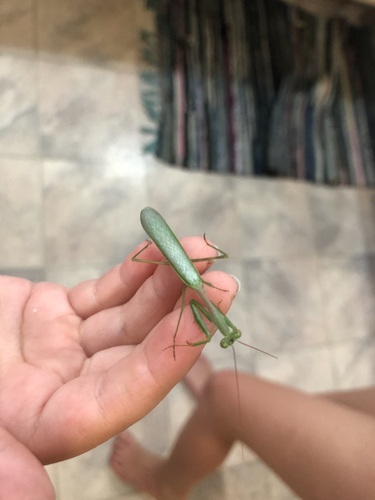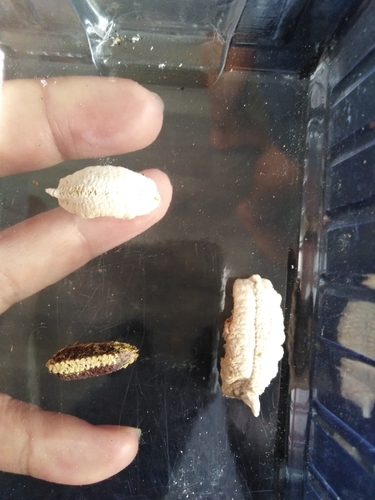StayiNatHome: can you find a praying mantis in your garden?
Praying mantises are fantastic sit-and-wait ambush predators. Their forelegs are massive and reach out to grab unsuspecting prey. In doing so, mantises help to keep other insect populations in check. There could well be some living out in your garden right now. Next time you're outside, have a look and let us know what you find with the iNaturalist app.
A tale of two mantises
It gets more interesting than that though. Did you know that there are now two praying mantis species wild in New Zealand? There's our home grown native, Orthodera novaezealandiae, and a larger South African species, Miomantis caffra. Miomantis caffra, was first found in NZ in 1978 by Auckland school boy, Richard Cuthbert, at his home. That's citizen science and StayiNatHome long before either were a thing.Below are a couple of observations from #StayiNatHome over the past week.


On the left, Valerie (@blacv1) found this NZ praying mantis at home in Christchurch. Note the broad thorax and the blue spot on the foreleg. On the right, @kblackfoto found this South African mantis in a garden in Papamoa. Note the narrow hour-glass shaped thorax. The South African also has all-green legs.
Our native mantis is in decline
If you are living in the north of New Zealand, there is growing concern that our native mantis is now getting hard to find. Miomantis is most likely the mantis you now have in your garden. The perception is that Miomantis has replaced Orthodera in open areas like urban gardens. Because of this, the Department of Conservation now lists our native Orthodera as “At Risk-Declining”.How the two species interact, and how and where Miomantis caffra is spreading, are still areas of active research. Your observations from your garden can help scientists to better understand what is going on.
University of Auckland Masters student Murray Fea did his thesis research on these two species in 2011. His climate modelling indicated that the South African should do just fine throughout much of the South Island, as well as the northern areas where it now thrives. It's worth watching out for in the south.
Murray also found that our male native mantises find the female South African mantises even more attractive than female native mantises. Unfortunately, the female South African mantises have a habit of eating their Kiwi amorous sutors. Murray has speculated that this might be the main reason why Orthodera novaezealandiae has been declining in the parts of NZ where Miomantis caffra is abundant. (Watch who you try to mate with.)
Mantises in our regions
We've just had a look at all of the praying mantis observations on iNaturalist NZ–Mātaki Taiao to look at how the percentage of mantises that are our native species changes throughout the country. Here's what we found:| Region | Orthodera (NZ) | Miomantis (SA) | %NZ |
|---|---|---|---|
| Northland | 18 | 57 | 24 |
| Auckland | 87 | 267 | 25 |
| Waikato | 32 | 44 | 42 |
| Bay of Plenty | 19 | 54 | 26 |
| Gisborne | 6 | 25 | 19 |
| Hawke’s Bay | 19 | 34 | 36 |
| Taranaki | 24 | 44 | 35 |
| Manawatū-Whanganui | 36 | 93 | 28 |
| Wellington | 191 | 24 | 89 |
| Tasman-Nelson | 4 | 49 | 8 |
| Marlborough | 12 | 59 | 17 |
| Canterbury | 290 | 8 | 97 |
| West Coast | 0 | 2 | 0 |
| Otago | 20 | 0 | 100 |
| Southland | 0 | 0 | - |
| TOTAL | 779 | 801 | 49 |
There are some surprises in there. Apart from Wellington, the South African mantis now dominates all of the North Island's regions. In Tasman-Nelson, we've had very few native mantises reported. Alarmingly, of our 53 observations from that area, only 4 were of our native mantis. Gulp. The West Coast and Southland look to be terrible places for all mantises. If you find any there, please share them on iNaturalist NZ.
In better news, despite the modelling projections, our native mantis continues to dominate in Canterbury and Otago. That may change though, as the South African mantis hasn't been in Canterbury for long (our earliest observation is 2004, and the only one until 2016), and it's yet to be observed on iNaturalist NZ in Otago.
Also, what's going on in the Waikato? There's a much higher proportion of native mantises in the Waikato than any of the adjacent regions. Could it be an unexpected upper North Island stronghold? If you're in the Waikato, please let us know what praying mantises are living in your gardens.
We need your observations
We need more observations of mantises from Kiwi gardens, from everywhere, but especially those regions with few observations. If you want a break from your bubbles, why not pop out into your garden for a mantis hunt. The nymphs and adults can be pretty cryptic. They're good at lurking secretively. However, the egg cases are often easy to find, on warm walls, tree trunks, and other flat vertical surfaces.
@loretta30 in Whangarei found these two South African praying mantis egg cases (top and lower right) laid next to a NZ mantis egg case (lower left).
Thankfully, the two species are easy to tell apart, as eggs, nymphs, and adults. If you find a mantis, you can just photograph it and share it with the iNaturalist app and our insect experts will ID it for you. Or, if you want to try it yourself, check out the table of features below.
| Orthodera (NZ) | Miomantis (SA) |
|---|---|
| Green body with bright blue and yellow markings under forelegs | All yellow-green, sometimes dark orange to pale straw coloured |
| Wide shield-like back (thorax) | Narrow “waste” at thorax |
| Adults a little smaller than Miomantis and female abdomen not nearly as swollen. | Adult female with massive egg-filled abdomen |
| Egg case narrow, tall, and without a protruding pointed tip | Egg case broad and rounded with a protruding pointed tip |
Finally, since we're now on the slow slide towards winter, there's another interesting aspect of mantis biology worth sharing. In my garden in Christchurch, I've watched the female NZ praying mantises lay her eggs and stay near them guarding them for as long as she is able, before finally succumbing to the winter cold.
If you find mantises at home, please photograph them and share them with the iNat app, but also be sure to take the time to watch them and soak in the insect dramas going on every day in your garden. If you're lucky like @jacqui-nz, you might even see one get eaten by a kingfisher!
Read more
Ramsay, G. W. 1984. Miomantis caffra, a new mantid record (Mantodea: Mantidae) for New Zealand. New Zealand Entomologist, 8:102–104.







Comments
I have two NZ mantises (one adult and one older juvenile) on the Day Lily (Hemerocallis) by the back deck. They are patiently waiting for their meals to come by.
Thanks @dougalm. I would be great if you could pop up observations of those. We'd also be interested in what they're eating ,if you're lucky enough spy them catching something.
Hi Jon, you might be interesting in the attached observation I made of a NZ mantis eating a white butterfly.
https://inaturalist.nz/observations/38382929
Thanks @dougalm. Yes, that's interesting. As I've just commented on your observation, we've had three other obs of NZ praying mantises eating cabbage white butterflies. I suppose the toxins in the cabbage whites that deter birds from eating them don't work for praying mantises. I expect there's an interesting biochemistry story in there.
Hi Jon, there is a good population of NZ mantis (Orthodera) in my garden in Brooklyn, Wellington. I have not seen the introduced South African one here. I'll post some photos soon. Cheers!
Thanks @dougalt. That's good to know, and reinforces what we're seeing the in the iNat NZ observations. Wellington is still a stronghold for native NZ praying mantises, much more so than any other North Island region, and also curiously much more so than the upper South Island. I don't understand that.
It's good to keep the observations flowing in, as it's not at all certain that these patterns are stable. The South African mantis might still be on the rise in Wellington and Canterbury.
Also valuable are any observations of interactions between the two species. Perhaps male NZ mantises further south are less enamored with female South Africans, or less likely to come into contact with them, than male NZ mantises further north. It feels like there's more going on here than has been revealed by researchers so far.
Having seen a native mantis in another local park, I've been removing SA egg cases from my property and encouraging others to do the same. I hope that at some point we can turn it around up north and tip the balance back in favour of the native species.
@ryvesie That's great. Good luck!
It would be good to try out this effort across a series of parks, some where all the SA egg cases are removed, and others we're they're left alone, and see how much difference that makes to the numbers of native praying mantises over time. I'm really not sure how big, or small, a difference this would make. It would be interesting to know. If it worked well, that could be good evidence to ramp up this effort across North Island towns and cities.
Nice work Jon. From memory when I was in Paeroa over summer hols all the egg cases were Miomantis!
Thanks @ecoman. It's remarkable how successful Miomantis has been in the north.
Hi all, I have 2 SA Praying Mantis in my garden (1 female and 1 male) getting close to each other. The male was not even here yesterday. I have just posted an observation. What do you recommend to do with them? I really don't feel like getting rid of them... :(
Hi i have seen a South Africa Praying Mantis mating with the NZ praying mantis and i live in Te Aroha.
We just spotted a NZ native one in Hobsonville Auckland.
Definitely seen a praying mantis muching on what looks like a shrivelled up cabbage looper caterpillar amongst my tomatoes. They're welcome there! I'm in Auckland.
Many SA mantids here in Waikanae, including many juveniles on my property.
Have not seen any NZ mantids here.
Add a Comment